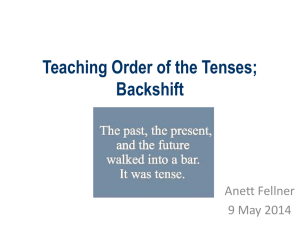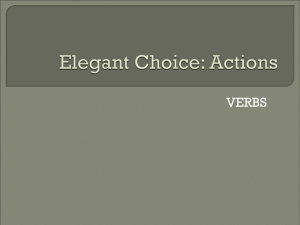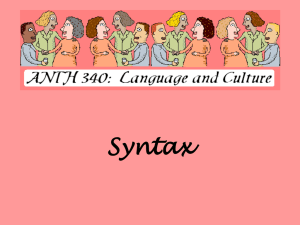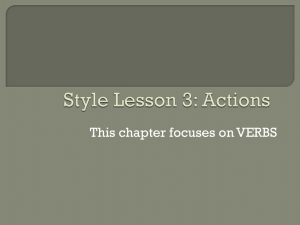Phrases, Clauses, & Sentence Structure
advertisement
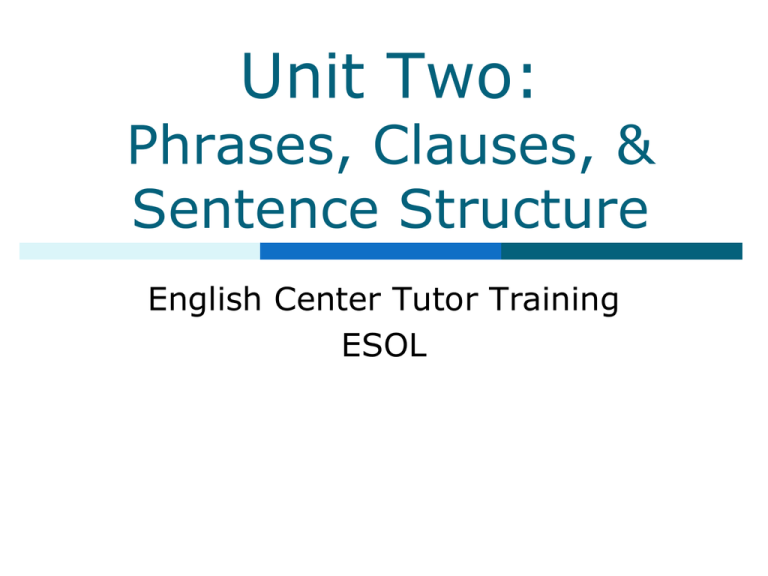
Unit Two: Phrases, Clauses, & Sentence Structure English Center Tutor Training ESOL Table of Contents Unit 1: Parts of Speech Unit 2: Phrases, Clauses, and Sentence Structure Unit 3: Simple & Progressive Verbs Unit 4: Perfect & Passive Verbs Unit 5: Complex Sentences Unit 6: Overview of City ESOL Program Introduction This could be the single most important unit to assist ESOL students’ success. Difficulty with sentence structure is often times what results in incomprehensible sentences and failure to convey meaning. Phrases Combine the noun phrases and verb phrases to make complete sentences. 1. a noun (and its modifiers) bands many culturally diverse students the City College book fair my magically delicious Lucky Charms those poisonous red apples on the table an interesting dream the drawer next to the bed talented and helpful tutors 2. a verb (and the words that follow) attend this school have been playing all night long has been on my mind all day will be in high demand open were for Snow White and not for you is always in October were eaten by the boy next door Clauses the little when didn’t kitten Iout go to understand sitting the store in thethe shade instructions of he they cried stayed all night the tree A clause is a subject / verb combination. Clauses can be dependent or independent (More explanation on this later) First, let’s practice distinguishing phrases and clauses. Determine which of the examples are phrases and which are clauses. Phrases Clauses Clauses There are two types of clauses: independent and dependent. An independent clause, or main clause, is a subject/verb combination that makes a complete sentence. A dependent clause cannot stand alone, and must be attached to an independent clause. In the following sentence, which one is the main clause? Example 1: As soon as I woke up, I made the coffee. If you said I made the coffee, then you are correct! Complete Sentences A complete sentence includes: 1. Subject (noun) 2. Verb (may need a direct object or complement) 3. Complete Thought/Idea 3. Example 1: Marcel understands the importance of attending class regularly. subject verb Example 2: Shu, Tony, and Ana studied together after class. verb subject 7 Not all complete sentences have a stated subject. The command form (also known as the imperative) has you as the implied subject. This sentence structure is not common in academic writing… except perhaps as a “hook” in an introductory paragraph. For example: Be careful! Moreover, certain authors and genres do not adhere to traditional sentence structure and may use phrases and dependent clauses as complete sentences. For example: Because I said so. Subjects The subject may be A single noun College is challenging. A noun phrase The English Center can help you succeed. A pronoun It is open Monday through Friday. Rose, Todd, Humberto, and Jess are all tutors there. Two or more nouns, noun phrases or pronouns Online tutoring is available on weekends. A gerund (verb + -ing) An infinitive (To + verb) . To err is human. 9 ESOL students frequently have incorrect sentence structure due to missing subjects in their sentences. It is often times the “dummy” it or there that is missing. For example: It is raining outside. Additionally, it is common for ESOL students to use a prepositional phrase as a subject. For example: In the morning is a good time to take classes. Scene One A student’s sentence is In the article says global health is important. There are many ways to assist him in correcting this error. Here’s one: Tutor: What is the subject of this sentence? Student: “Article.” Tutor: Not quite. What part of speech is “in?” Student: A preposition. Tutor: Correct. Prepositions need a noun for an object, and “article” is the object of the preposition. So it can’t be the subject of the sentence. So what is the subject of the sentence? This is a trick question. Student: There isn’t one. Tutor: That’s right! So how can you correct this? Student: I can take away the preposition and just write, “The article says global health is important.” Tutor: Excellent. Scene Two A student’s sentence is In the article says global health is important. There are many ways to assist him in correcting this error. Here’s another: Tutor: What is the subject of this sentence? Student: “Article.” Tutor: Not quite. What is the verb of the sentence? Student: says. Tutor: Correct. So what is the subject? Student: Global health. Tutor: Not quite. The subject has to go before the verb. Student: There isn’t a subject. Tutor: Correct! So how can we change it? Student: I can add “it” so that the sentence says “In the article, IT says global health is important.” Tutor: Perfect. Verbs There are different categories of verbs, some of which require a direct object or complement to make the sentence complete. These are called transitive verbs. (Memory trick: Transitive verbs are like a train; they need a caboose.) Intransitive verbs do not require a direct object or complement. Note: ESOL students don’t need to know the terms “transitive” and “intransitive.” Direct Objects A direct object is the noun that is receiving the action of the verb. 1. Some verbs must take an object *We analyzed. We analyzed the data. 2. Some verbs may take an object. It’s correct with or without. We wrote. 3. Some verbs cannot take an object She disappeared. *She disappeared the dog. ESOL students may have difficulty understanding these differences as there isn’t a logical reason why certain verbs take direct objects and others do not. Helping them identify and memorize common verbs and how they are used will improve their writing. Complements A complement is a word or words that follow the verb but aren’t direct objects. Depending on the verb, some are obligatory. Example 1: Rufus seems. Example 1 is not a complete sentence because the verb requires a complement. The example should be: Rufus seems extraordinarily sleepy. Example 2: Rufus walks. This is a complete sentence. However, we can add a complement if we want to be more precise. The example could be: Rufus walks with vigor. Complements There are three types of phrases that can act as complements. 1. A noun or noun phrase 1. George Michael is a brilliant lyricist. 2. An adjective or adjective phrase 1. George Michael is brilliant. 3. A prepositional phrase 1. George Michael is on tour. It’s important to distinguish between direct objects and complements as knowing which verbs take a direct object is vital when forming the passive. Example 1: Rufus is a good dog. A good dog is not the direct object as it is not receiving the action of the verb. Thus, it cannot be made passive. Example 2: Rufus fetched the ball. Here, the ball is the direct object, and the sentence can be made passive: The ball was fetched by Rufus. (More explanation on this later.) The verb of a sentence must be complete or include all necessary verb parts. Often times ESOL students leave out part of the verb. Example 1: She working in the lab. This would be incorrect as the progressive requires the verb to be. It should be: She is working in the lab. A sentence can consist of more than one verb. However, parallel structure is important. ESOL students frequently use different verb forms or tenses when consistency is needed. She works, studies, and is taking care of her children. Example 1: The three verbs are not the same form. The example should be: She works, studies, and takes care of her children. Complete Sentences? 1. Choosing a major is an important decision. 2. Because I study a lot. In my college have a cafeteria and several snack areas. 3. 4. It is difficult to study on the weekend. There three things to do to be a successful student. 5. 6. While I was in my ESOL 30 class. My college has many buildings, so easy to get lost. 7. Types of Sentences There are four types of sentences. 1. Simple Sentences Roxie is a dog. 2. Compound Sentences Roxie is a dog, and Rufus is her friend. 3. Complex Sentences Rufus loves Roxie because she is adorable. 4. Compound-Complex Sentences Rufus loves Roxie because she is adorable, and she defers to him. Simple Sentences Simple sentences are single, independent clauses. Subject + verb Rufus runs. Subject + verb + object or complement Roxie is a dog. Compound Sentences Compound sentences consist of two independent clauses that are combined with a coordinating conjunction. Formula: IC, cc IC. Coordinating Conjunction = cc Independent Clause = IC I like ice cream, and Judy likes cookies. IC , cc IC. Coordinating Conjunctions F or = because I like ice cream, for it is delicious. A nd = more information I like ice cream, and Judy likes cookies. N or = two negative options Neither ice cream nor cookies are good for your health. B ut = contrast I like ice cream, but I don’t like cake. O r = alternative I could eat ice cream, or I could eat carrots. Y et = contrast I could carrots, yet I wouldn’t feel happy. S o =result/consequence I will eat ice cream, so I can feel happy. The coordinating conjunctions for and nor are not very common. Thus, it would be a better use of time to assist students with the other coordinating conjunctions. It’s important to focus on mastering simple sentence structure before tackling compound or complex. If a student is struggling with more difficult grammar, go back to the basics. Make sure that they can identify and produce comprehensible phrases, then clauses, then simple sentences before compound or complex. Complex sentences will be explored more fully in unit five. Sentence Structure Each of the sentences on the next slide has a problem with sentence structure. Find and correct the one sentence-structure error in each of the sentences. Correct the Sentence Structure Error 1. In my opinion, speaking in English easier than writing in English. is 2. Is a very interesting point you have raised. It 3. My summer internship, for example, it is one way for me. 4. am At present, I am finishing a project, and I also starting a new one. 5. I felt happy. Because I moved to the U.S. I felt happy because I moved to the U.S.
